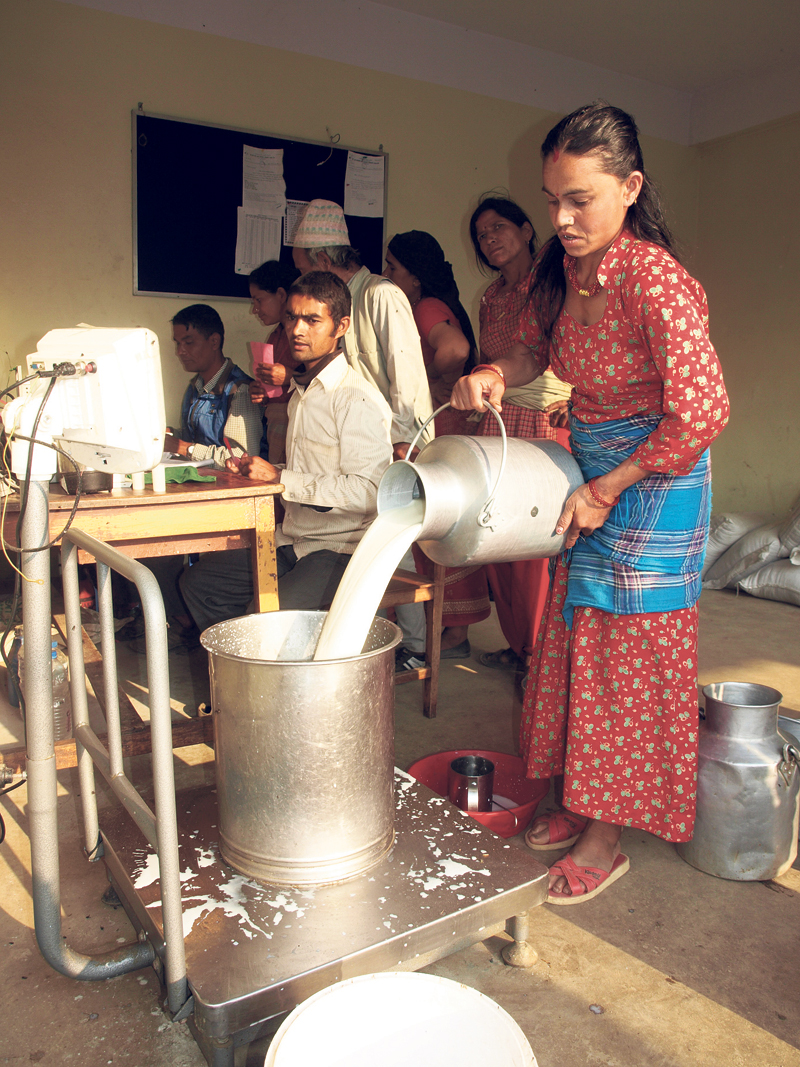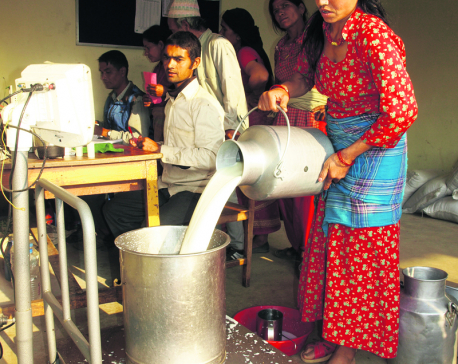
OR
Kavre district declared self-sufficient in milk production
Published On: July 30, 2016 06:46 AM NPT By: Madhu Sudan Guragain

BANEPA, July 29: Despite being a nation with agriculture at the core of its economy, much of the country reels under shortage of dairy produce. In such a scenario Kavre district has become the first district to become self-sufficient in dairy produce. The government on Thursday declared the district as the country’s first district to achieve the target of self-sufficiency in milk production.
“Our district has made commendable progress in milk production,” Dr. Narayan Bahadur Shrestha, chief of Kavre District Livestock Service Office (DLSO), said. “Kavre has met all the criteria set by the government to be declared as self-sufficient in milk production. The newly gained status reflects hard work of the farmers and they deserve the honor,” he added.
This is the first time ever that Ministry of Livestock Development has made such announcement. The process for declaring a district has to go through multiple levels of checks. The decision was reached after the multiple analysis of milk product statistics records, cross checking the accuracy of data recorded and after analyzing the judgments delivered by all the DLSO officials.
Elaborating on the production capacity of the district, Shrestha informed that the district contributes significant amount of milk production in the country. “World Food Organization requirement of person milk consumption is set at 91 liters per year on average. Considering this benchmark, Kavre has outdone it. The district’s annual milk consumption is around 315 liters. This is a commendable feet and we are very happy about it.”
The achievement, Shrestha elaborated, has been gained through the contribution of multiple actors. The farmers have been assisted by various government and non-governmental agencies with various level of support. He informed that the Fodder and Pasture Development Program, and Youth in Agriculture Program in the district have played a significant role in increasing the overall production of the dairy.
Apart from them, Shrestha shared that the district has been able to boost the farmers’ production due to the financial support extended by various financial institutions. “While government and non-government agencies assisted in raising awareness among farmers about the benefits of dairy business, and in improving their livestock skills, banks and financial institutions and insurance companies supported the farmers by trusting their abilities and funding their initiatives,” said Shrestha.
Various banks in the district have invested about Rs 130.4 million rupees altogether in milk production. “The banks provided easily accessible loans at just six percent interest rate, providing farmers with much-needed encouragement,” he said.
According to the DLSO, the district chapter of the Rastriya Banijya Bank, Nepal Bank and Agricultural Development Bank are some of the major loan providers in the district. Likewise, nine insurance companies based in the district have provided insurance coverage to 3,008 livestock across the district. Along with them, insurance cooperatives have also insured about 800 livestock.
The district has around 400 milk collection centers that collect a total of 300,000 liters milk daily. The district exports around 80 percent of its daily milk production to Kathmandu valley.
DLSO informed that around 120,000 metric ton of milk was produced by the district during the last fiscal year of 2014/015. Proximity to Kathmandu valley along with easy collection centers is regarded as other major factors behind the boom of dairy production in the district.
A total of 164 cow farms and 161 buffalo farms have been formally registered at the DLSO. According to the data of last fiscal year maintained by the office, the district has about 139,000 cows whereas the number of buffaloes stands at 131,000. This number is three percent higher than the last fiscal year. The district has as many as 272 milk production cooperatives. Farmers affiliated to these cooperatives produce milk on a daily basis.
Though the district has been declared as the first self-sufficient in milk production, it still has a long way to go in terms of modernizing of livestock farming, an official at DLSO said, adding that challenges for the farmers in the days ahead will be in terms of maintaining quality of their produce.
Shanta Manavi, Minister of Livestock Development, awarded the recognition certificate to Ram Krishna Upreti, Local Development Officer of the district amid a special program organized in the district headquarters on Friday. On the occasion, the Minister announced specific plans and initiatives of the government to make the whole country self sufficient in milk production.
You May Like This

Rasuwa declared as 43rd literate district
RASUWA, Feb 13: As per the 'Literate Nepal' mission launched in 2012, the government has now declared 43 districts of the... Read More...

Dairy stakeholders of Kavre committed to improving milk quality
BANEPA, March 23: After becoming self-sufficient in dairy products, dairy stakeholders of Kavre have said that they would now focus on... Read More...

Parbat self-sufficient in milk, vegetables
GULMI, Aug 2: Some years ago, Parbat used to import vegetables and milk from Pokhara. The scenario has changed now.... Read More...







Just In
- Govt appoints 77 Liaison Officers for mountain climbing management for spring season
- EC decides to permit public vehicles to operate freely on day of by-election
- Fugitive arrested after 26 years
- Indian Potash Ltd secures contract to bring 30,000 tons of urea within 107 days
- CAN adds four players to squad for T20 series against West Indies 'A'
- ‘Precast' technology introduced in the construction of bridges along Muglin-Pokhara road
- Leopard attack injures young man in Kanchanpur
- SC rejects writ petition filed against Home Minister Lamichhane












Leave A Comment